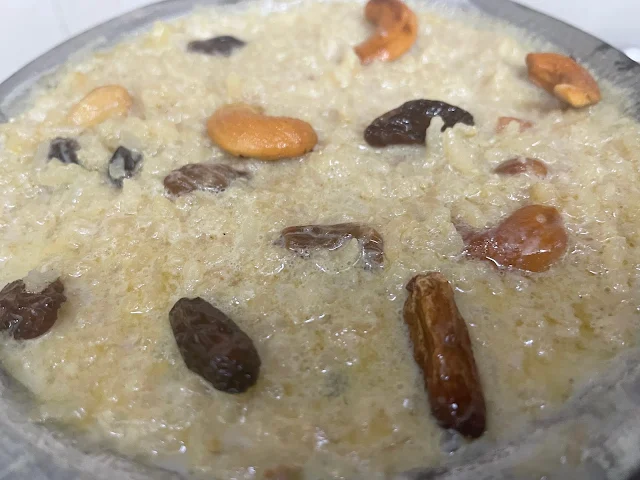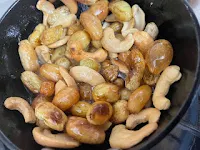Rice Payasam | Rice Pudding Recipe | Sweet Rice Dessert | Indian Rice Dessert | Traditional Rice Dessert | Rice Kheer | Sweet Rice Pudding | Rice Dessert Recipe | South Indian Dessert | Easy Payasam Recipe | Biyyam Payasam
- Preparation Time: 15 minutes
- Cooking Time: 45 minutes
- Total Time: 1 hour
- Servings: 6-8
1. Introduction:
Cashew
Raisin Payasam, also known as Sweet Rice Pudding is a beloved dessert steeped
in tradition and cherished for its comforting flavors. This delectable treat
holds a special place in Indian Culinary heritage, symbolizing warmth,
hospitality, and abundance. Join me on a journey as we explore the origins,
cultural significance, health benefits, and step-by-step preparation of this
timeless delicacy.
2. History
and Cultural Significance:
Cashew
Raisin Payasam traces its roots back t ancient Indian Culinary traditions,
where it served as a staple dessert in homes, temples, and royal feasts. The
word "payasam" derives from the Sanskrit word "payasa,"
meaning milk in nectar, highlighting its rich and creamy texture. Over the
centuries, payasam has become an integral part of Indian festivals, rituals,
and celebrations, symbolizing, prosperity, sweetness, and the joy of sharing.
Its preparation varies across regions and communities, with each recipe
reflecting unique ingredients, flavors, and culinary customs.
In South
India, payasam holds particular significance, featuring prominently in
religious ceremonies, weddings, and festive occasions. It is often offered as
prasad (divine offering) in temples and shared among family and friends as a
gesture of love and goodwill. The act of preparing and serving payasam fosters
bonds and strengthens relationships, embodying the spirit of togetherness and
hospitality that defines Indian Culture.
3. Importance and
Occasions:
Cashew
Raisin Payasam holds a special place in the hearts of millions, serving as a
symbol of joy, abundance, and celebration. It is traditionally prepared during
auspicious occasions such as weddings, childbirth ceremonies, and religious
festivals like Diwali, Pongal, Navratri. The sight and aroma of simmering
payasam evoke memories of family gatherings, festive feasts, and cherished
moments shared with loved ones. It’s comforting sweetness brings warmth to cold
winter nights and solace during times of sorrow, making it a beloved dessert
for all occasions.
4. Who can Enjoy It?
Cashew
Raisin Payasam is a dessert that transcends age, gender, and cultural
boundaries, delighting taste buds and warming hearts with its creamy goodness.
Whether served to children after a long day at school. Shared among friends
during a festive feast, or savored by elders reminiscing about days gone by,
this dessert brings smiles and satisfaction to all who partake in its
indulgence. It's simple yet irresistible flavors appeal to food lovers of all
ages, making it a timeless favorite in Indian households and beyond.
5. Uses
and Benefits of having this recipe:
Apart from
its delightful taste, Cashew Raisin Payasam offers plethora of health benefits,
thanks to its nutritious ingredients and traditional preparation methods.
Cashews, rich in vitamins, minerals, and healthy fats, provide a source of
energy and promote heart health, while raisins offer natural sweetness and
fiber, aiding in digestion and gut health. Jaggery, a traditional sweetener
made from sugarcane or palm sap, is a healthier alternative to refined sugar,
providing iron, calcium, and other essential minerals. When combined with milk
and rice, these ingredients create a nourishing and wholesome dessert that
satisfies both the palate and the body.
6. Ingredients:
- Cashews -
10g
- Raisins -
10g
- Cardamom
Powder - 1 tsp
- Ghee
(clarified butter) - 3 tsp
-Milk - 1
liter
-Basmati
rice/rice - 1 cup
- Jaggery -
1 cup (grated or powdered)
7. Detailed Cooking Instructions:
1. Preparation: Begin
by gathering all the ingredients required for making Cashew Raisin Payasam.
Rinse the basmati rice thoroughly under cold running water and soak it in water
for about 30 minutes to soften.
2. Preparation
of Cashews and Raisins: In a small skillet or kadai, heat 1
teaspoon of ghee over medium heat. Once the ghee is hot, add the cashews and
fry them until they turn golden brown and crispy. Be sure to stir frequently to
prevent burning. Once the cashews are fried, remove them from the skillet and set
aside. In the same skillet, add the raisins and fry then until they plump up
and become slightly golden in color. Remove the raisins from the skillet and
set aside.
3. Boiling
Milk: In a large heavy-bottomed saucepan or kadai, pour the milk
and bring it to a gentle boil over medium heat, stirring occasionally to
prevent scorching. Allow the milk to simmer gently until it reduces slightly
and thickens.
4. Cooking
Rice: Drain the soaked rice and add it to boiling milk. Stir well to
combine and reduce the heat to low. Allow the rice to cook in the milk,
stirring occasionally to prevent sticking, until it becomes soft and fully
cooked. This process may take approximately 20-25 minutes.
5. Sweetening
with Jaggery: Once the rice is cooked and the mixture thickens to a
pudding-like consistency, add the grated or powdered jaggery to the saucepan.
Stir well until the jaggery dissolves completely into the rice and milk
mixture, imparting its rich sweetness and caramel-like flavor.
6. Final
Flavoring: In a small saucepan, melt the remaining 2 teaspoons of ghee
over low heat. Add the cardamom powder to the melted ghee and stir well to
combine. Pour this fragrant mixture into the rice pudding and mix thoroughly to
infuse the flavors.
7. Adding
Cashews and Raisins: Finally, add the fried cashews and raisins to
the rice pudding, reserving a small portion for garnish if desired. Stir well
to distribute the nuts and raisins evenly throughout the pudding, adding a
delightful crunch and burst of sweetness to each bite.
8. Serving: Your
aromatic and flavorful Cashew Raisin Payasam is now ready to be served hot or
chilled, according to your preference. Ladle the pudding into individual serving’s
bowls and garnish with a few reserved cashews and raisins for an extra touch of
elegance.
8. Cooking
Tips:
- Soaking
the rice before cooking helps to soften it and reduce the cooking time.
-Frying the
cashews and raisins in ghee enhances their flavor and adds a delightful crunch
to the pudding.
-Be sure to
stir the milk and rice mixture frequently to prevent it from sticking to the
bottom of the saucepan and burning.
-Adjust the
quantity of jaggery according to your taste preferences and the sweetness of the
jaggery used. You can also use sugar as a substitute for jaggery if desired.
-For a
richer flavor, you can add a few strands of saffron or a splash of rose water
to the pudding along with the cardamom-infused ghee.
9. Nutritional
Information (Per Serving):
- Calories:
250 kcal
-
Carbohydrates: 40g
- Protein:
6g
- Fat: 8g
- Fiber:
1.5g
- Sugar: 20g
In final
words, Cashew Raisin Payasam is more than just a dessert; it's a timeless
tradition that embodies the spirit of togetherness, celebration, and sweetness.
From its humble origins in Indian Kitchens to its place on festive tables
around the world, this indulgent treat continues to bring joy and satisfaction
to all who savor its creamy goodness. Whether enjoyed on special occasions or
as a comforting dessert on a cold winter's night, Cashew Raisin Payasam is sure
to leave a lasting impression with its rich flavors and cultural significance.
So, gather your loved ones, whip up a batch of this delightful dessert, and
savor the taste of tradition and togetherness with every the spoonful.






Comments
Post a Comment